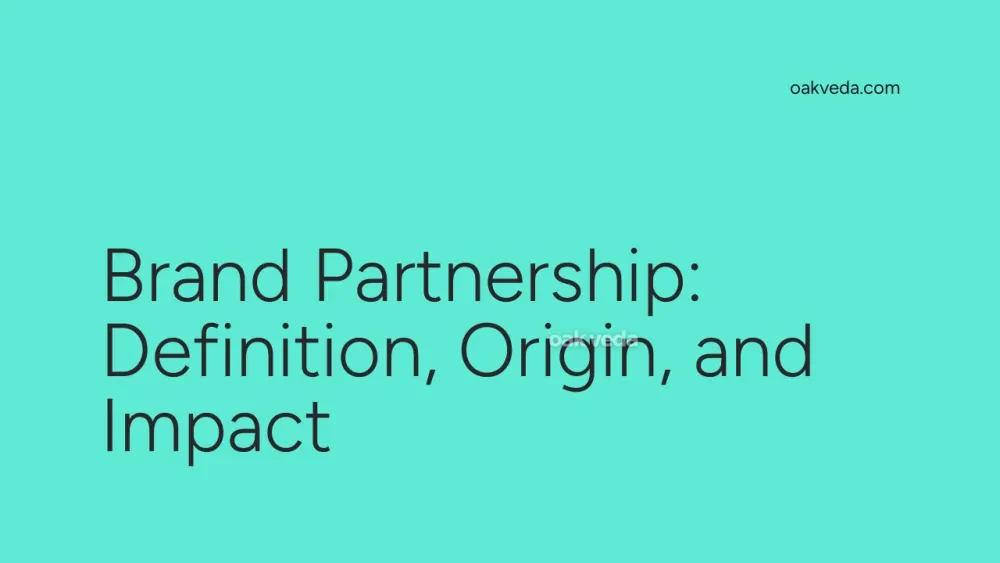
What is a Brand Partnership?
A brand partnership is a strategic collaboration between two or more brands, influencers, or content creators with the goal of achieving mutually beneficial outcomes. In the context of social media marketing, these partnerships typically involve joint marketing campaigns, co-created products or services, or promotional activities designed to leverage each partner's strengths and audience reach.
Origin and Development of Brand Partnerships
Brand partnerships have been a part of marketing strategies for decades, but their evolution in the digital age has been remarkable. With the rise of social media platforms and influencer marketing, brand partnerships have become more accessible, diverse, and impactful than ever before.
The concept gained significant traction in the early 2010s as social media influencers began to amass large followings. Brands recognized the potential of collaborating with these influencers to reach highly engaged audiences in a more authentic and relatable manner.
How Brand Partnerships Work
Brand partnerships in social media typically follow these steps:
- Identification: Brands identify potential partners (other brands, influencers, or creators) with complementary values and target audiences.
- Negotiation: Partners discuss terms, including compensation, content requirements, and posting schedules.
- Content Creation: Collaborators develop content that aligns with both parties' brand identities and marketing goals.
- Review and Approval: Brands review and approve the content before it's published.
- Publication: The content is shared across agreed-upon social media platforms.
- Performance Tracking: Both parties monitor the partnership's success through various metrics.
Types of Brand Partnerships
Brand partnerships can take various forms, including:
- Co-branded Products: Two brands collaborate to create a unique product.
- Influencer Collaborations: Brands partner with social media influencers for sponsored content.
- Cross-Promotions: Brands promote each other's products or services to their respective audiences.
- Joint Campaigns: Multiple brands unite for a shared marketing initiative or cause.
- Content Collaborations: Brands work together to create engaging content, such as videos, podcasts, or blog posts.
Popular Examples of Brand Partnerships
-
GoPro and Red Bull: These brands frequently collaborate on extreme sports events and content creation, leveraging their shared audience of adventure enthusiasts.
-
Spotify and Starbucks: This partnership allows Starbucks employees to curate playlists on Spotify, enhancing both brands' customer experiences.
-
Nike and Apple: Their long-standing collaboration has produced co-branded products like the Nike+ Running App and Apple Watch Nike+.
Impact of Brand Partnerships on Social Media Culture
Brand partnerships have significantly influenced social media culture in several ways:
- Content Diversification: Collaborations lead to more varied and creative content across platforms.
- Authenticity: Well-executed partnerships can make branded content feel more genuine and relatable.
- Community Building: Partnerships often bring together different communities, fostering new connections.
- Trend Setting: Successful collaborations can spark trends and influence consumer behavior.
Controversies Surrounding Brand Partnerships
While brand partnerships can be highly effective, they're not without controversies:
- Transparency Issues: Some partnerships fail to clearly disclose their sponsored nature, leading to consumer distrust.
- Authenticity Concerns: Poorly matched partnerships can appear inauthentic, damaging both brands' reputations.
- Oversaturation: As partnerships become more common, there's a risk of audience fatigue and decreased engagement.
How Brands and Influencers Use Brand Partnerships
Brands and influencers leverage partnerships to:
- Expand Reach: Access new audiences and markets.
- Enhance Brand Image: Associate with complementary brands to strengthen positioning.
- Increase Engagement: Create more compelling content that resonates with followers.
- Drive Sales: Collaborate on limited-edition products or exclusive offers.
- Build Trust: Leverage the credibility of trusted influencers or established brands.
Future Trends in Brand Partnerships
Looking ahead, we can expect to see:
- Micro-Influencer Focus: Brands partnering with niche influencers for more targeted campaigns.
- Long-Term Collaborations: Shift towards sustained partnerships rather than one-off campaigns.
- Virtual and Augmented Reality: Increased use of immersive technologies in collaborative content.
- Social Commerce Integration: More partnerships centered around seamless in-app purchasing experiences.
- Data-Driven Matchmaking: Advanced analytics to identify the most suitable brand-influencer pairings.
FAQs about Brand Partnerships
-
How do I find the right brand partner? Look for brands or influencers with complementary values, target audiences, and goals. Utilize social media listening tools and platforms like Later's Brand Collabs feature to identify potential matches.
-
What makes a brand partnership successful? Success factors include clear communication, aligned objectives, authentic content creation, and mutual benefit for all parties involved.
-
How do you measure the ROI of a brand partnership? Key metrics include engagement rates, reach, conversions, sales uplift, and brand sentiment changes. Use tracking tools and unique promotional codes to attribute results accurately.
-
Are brand partnerships only for large companies? No, businesses of all sizes can benefit from partnerships. Small brands often find success collaborating with micro-influencers or other local businesses.
-
How can I ensure my brand partnership is compliant with regulations? Always disclose sponsored content clearly, follow platform-specific guidelines, and adhere to local advertising regulations. When in doubt, consult with a legal professional specializing in digital marketing.
In conclusion, brand partnerships have become a cornerstone of modern social media marketing. When executed thoughtfully, they offer a powerful way to expand reach, enhance brand perception, and drive meaningful engagement. As the digital landscape continues to evolve, so too will the nature of these collaborations, presenting exciting opportunities for brands and creators alike.
You may be interested in:
- Influencer Marketing Software: Definition, Origin, and Impact
- Pinned: Definition, Origin, and Impact on Social Media
- Content Curation: Definition, Origin, and Impact
- ICYMI: Definition, Origin, and Impact on Social Media
- BeReal: Definition, Origin, and Impact on Social Media
- Evergreen Content: Definition, Origin, and Impact

